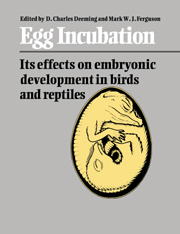Book contents
- Frontmatter
- Contents
- Preface
- Contributors
- 1 Maternal diet, maternal proteins and egg quality
- 2 Comparative composition and utilisation of yolk lipid by embryonic birds and reptiles
- 3 Oviductal proteins and their influence on embryonic development in birds and reptiles
- 4 Fluxes during embryogenesis
- 5 Eggshell structure and formation in eggs of oviparous reptiles
- 6 Shell structure and formation in avian eggs
- 7 Physical characteristics of reptilian eggs and a comparison with avian eggs
- 8 Egg-shape in birds
- 9 The thermal energetics of incubated bird eggs
- 10 Physiological effects of incubation temperature on embryonic development in reptiles and birds
- 11 Cold torpor, diapause, delayed hatching and aestivation in reptiles and birds
- 12 Physical factors affecting the water exchange of buried reptile eggs
- 13 Physiological and ecological importance of water to embryos of oviparous reptiles
- 14 Roles of water in avian eggs
- 15 Water economy and solute regulation of reptilian and avian embryos
- 16 The avian eggshell as a mediating barrier: respiratory gas fluxes and pressures during development
- 17 Gas exchange across reptilian eggshells
- 18 Metabolism and energetics of reptilian and avian embryos
- 19 Reasons for the dichotomy in egg turning in birds and reptiles
- 20 A comparison of reptilian eggs with those of megapode birds
- 21 Why birds lay eggs
- 22 Influences of incubation requirements on the evolution of viviparity
- 23 Overview of early stages of avian and reptilian development
- 24 Ions and ion regulating mechanisms in the developing fowl embryo
- 25 Electrochemical processes during embryonic development
- 26 Methods for shell-less and semi-shell-less culture of avian and reptilian embryos
- 27 Experimental studies on cultured, shell-less fowl embryos: calcium transport, skeletal development, and cardio-vascular functions
- Index
13 - Physiological and ecological importance of water to embryos of oviparous reptiles
Published online by Cambridge University Press: 16 November 2009
- Frontmatter
- Contents
- Preface
- Contributors
- 1 Maternal diet, maternal proteins and egg quality
- 2 Comparative composition and utilisation of yolk lipid by embryonic birds and reptiles
- 3 Oviductal proteins and their influence on embryonic development in birds and reptiles
- 4 Fluxes during embryogenesis
- 5 Eggshell structure and formation in eggs of oviparous reptiles
- 6 Shell structure and formation in avian eggs
- 7 Physical characteristics of reptilian eggs and a comparison with avian eggs
- 8 Egg-shape in birds
- 9 The thermal energetics of incubated bird eggs
- 10 Physiological effects of incubation temperature on embryonic development in reptiles and birds
- 11 Cold torpor, diapause, delayed hatching and aestivation in reptiles and birds
- 12 Physical factors affecting the water exchange of buried reptile eggs
- 13 Physiological and ecological importance of water to embryos of oviparous reptiles
- 14 Roles of water in avian eggs
- 15 Water economy and solute regulation of reptilian and avian embryos
- 16 The avian eggshell as a mediating barrier: respiratory gas fluxes and pressures during development
- 17 Gas exchange across reptilian eggshells
- 18 Metabolism and energetics of reptilian and avian embryos
- 19 Reasons for the dichotomy in egg turning in birds and reptiles
- 20 A comparison of reptilian eggs with those of megapode birds
- 21 Why birds lay eggs
- 22 Influences of incubation requirements on the evolution of viviparity
- 23 Overview of early stages of avian and reptilian development
- 24 Ions and ion regulating mechanisms in the developing fowl embryo
- 25 Electrochemical processes during embryonic development
- 26 Methods for shell-less and semi-shell-less culture of avian and reptilian embryos
- 27 Experimental studies on cultured, shell-less fowl embryos: calcium transport, skeletal development, and cardio-vascular functions
- Index
Summary
Introduction
Research on the water relations of reptilian embryos apparently originated with the descriptions by Dendy (1899), Brimley (1903) and Coker (1910) of swelling over the course of incubation by the flexible-shelled eggs of several chelonians and lepidosaurians (a term used here to refer to Squamata plus Sphenodontia; Benton, 1985). However, most of the current interest in this subject derives from the landmark studies by Cunningham and his associates (Cunningham & Hurwitz, 1936; Cunningham & Huene, 1938; Cunningham, Woodward & Pridgen, 1939) and by Fitch & Fitch (1967). These investigations were the first to demonstrate that reptilian eggs and embryos are affected profoundly by the availability of water in their environment, and they revealed also that the water relations of reptilian eggs differ in important ways from those of avian eggs. In retrospect, however, the experiments suffered from the absence at the time of a generally accepted method for quantifying the availability of water in substrates. Cunningham et al. used a qualitative approach and did not report the water content of substrates used to incubate eggs in their studies, while Fitch & Fitch expressed the water content of substrates gravimetrically. Neither of these methods is based upon thermodynamic principles. Thus, the studies have limited value in elucidating either the patterns or the mechanisms of water exchange by incubating eggs of reptiles (Packard & Packard, 1988a).
- Type
- Chapter
- Information
- Egg IncubationIts Effects on Embryonic Development in Birds and Reptiles, pp. 213 - 228Publisher: Cambridge University PressPrint publication year: 1991
- 54
- Cited by



